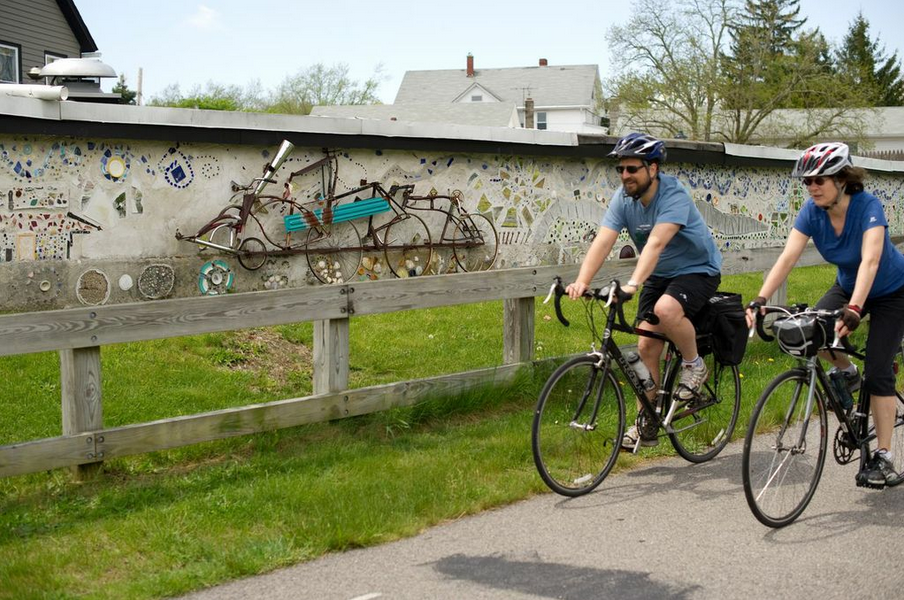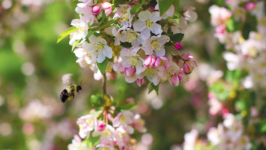Rhode Trip: Exploring the Inland Villages of South Kingstown on Two Wheels
A springtime tour of South Kingstown is well suited to a bicycle tour through several of the inland villages along the South County Bike Path (officially the William C. O’Neill Bike Path, after the state senator who pushed for its construction).
The four villages and one town that are inland all have some degree of commercial activity; good food; public art; natural features (such as parks, preserves, refuges); museums, historic buildings or cemeteries; and all but one (Usquepaugh) contain a good stretch of the six-mile South County Bike Path.
USQUEPAUGH
The tiny community of Usquepaugh, just five miles east of I-95, is the site of Kenyon’s Grist Mill. There’s been a mill here since 1696; the current building dates to 1886; the Kenyon family began to operate it in 1909. In the tiny store across the road from the mill, Kenyon’s sells a wider variety of products than often reaches its other Rhody retail outlets—for example, yellow, blue or red cornmeal, in addition to the traditional white flint corn for jonnycakes.
A short drive up this narrow twisty road is Peter Pots Pottery, making handcrafted stoneware since 1948. From bowls to bunny banks, from platters to plates, from tureens to trays, these lead-free items come in delicately shaded earth tones of green, blue and brown.
WEST KINGSTON
Just after the Kingston Railroad Station (a starting point for the bike path), you might grab a sandwich and coffee at Taylor’s Landing Coffee (known locally as TLC). Taylor’s roasts its own coffee and gets high marks from the locals.
Just across Route 138 from Taylor’s is the Sosnowski Farm Store, specializing in fresh products from the family farm a short distance away. A staunch advocate for Rhode Island’s farmland and farmers, State Senator Sue Sosnowski and husband, Mike, bring their harvest to the South Kingstown Farmers Market year-round. Their modest farm stand closes for about 10 winter weeks, but in early spring you might find greenhouse-raised greens and broccoli; winter-stored veggies, such as potatoes, carrots, squash and cabbage; eggs; or garden seedlings for home planting.
Although you could turn onto Route 110 just after Taylor’s and park at West Kingston Elementary School to hop onto the bike path, you’d miss the model railroad museum inside the historic 1875 Kingston Station, as well as the expansive mural (by Peruvian native/West Kingston resident Peruko Ccopacatty) on the lumberyard building across the tracks.
But more pertinent to the bike path, you’d miss the bridge over the Great Swamp, home to hundreds of wild critters—I’ve seen a large black snake throw itself across the path, a turtle amble to the grassy edge, a great blue heron coast overhead and a redwinged blackbird flit into the bushes. The Great Swamp is also home to historical markers about the Great Swamp Fight (or Massacre) of 1675 when colonial soldiers attacked a fort where Narragansett tribe members had taken shelter, killing hundreds and squelching the native uprising known as King Philip’s War.
After the bike path crosses Route 110, it passes woodsy areas, town athletic fields and a large housing development called Tefft Hill (containing a historic cemetery and Tefft Hill Park). But the houses mostly stay hidden; the scenery stays outdoorsy; West Kingston turns into Kingston somewhere along the way.
KINGSTON
If you want other lunch options, take a detour north on South Road to the Kingston Emporium, next door to the University of Rhode Island (URI) campus. It’s a collection of a dozen restaurants geared to the campus population, with various ethnicities and genres at play. Peking Tokyo has its own raised-bed vegetable garden next to the restaurant, and Simply Thai is simply delicious.
Continuing east on the bike path, more athletic fields and a middle school pop up, and a very interesting detour, still biking, takes you up behind those fields, onto a hiking trail and out to a neighborhood just off Route 108, which is the site of URI’s annual East Farm Spring Festival. Now in its 15th year, this festival has grown to include a halfdozen gardening workshops and demonstrations, more than two dozen exhibits, a greenhouse full of seedlings for sale, plus the South Kingstown Farmers Market, the state’s longest-running farmers’ market (since 1982).
Minus that detour, the path brings you past four access points to the web of trails around three ponds that make up Tri-Pond Park, a wonderful woodland mix of wetlands and hills, two dammed ponds, and lots of wildlife. Skimming past these tempting hiking trails, you can detour one block north on Rodman Street to Sons of Liberty Spirits Co. for a whiskey tasting and tour.
PEACE DALE
You can otherwise descend steeply into the village of Peace Dale, with its convivial (and delicious) Sweet Cakes Bakery just a few yards off the path, plus several pieces of art to examine along this short stretch. They include a tiny kiosk art gallery, sponsored by Hera Gallery; two murals, with bric-a-brac shards of pottery and bicycle parts worked into one and the other a fantasy journey from Peace Dale out into the galaxy; a glittering mosaic of Peace Dale’s historic buildings and connecting streets; a four-point archway of schoolchildren’s tiles; a sculpture of industrial parts; and Tom Ladd’s ceramic beehive sculpture, wood-fired in place as part of a community event.
Sweet Cakes is under new ownership (Jim Creighton, since 2011) and has added outside tables with an awning (in addition to a couple of inside tables), so it’s a great spot for breakfast, lunch or just coffee and pastries. And, ah, such pastries! Springtime will feature an egg-shaped cake, a “strawberry tall cake” and asparagus in their popular empanadas, most of them veggie-based.
It’s worth a loop to the left off the bike path, around the sprawling 19th-century mill building, to see the legacy of Rowland Hazard and his family (the village is named for his wife, Mary Peace). The granite library was once a public meeting place for mill workers, with the three-tiered stone basins next to it intended for horses, oxen and dogs. The stone building across from the library, once the mill’s company store, now houses the Museum of Primitive Culture (worth a stop); the Neighborhood Guild behind it, founded to offer domestic arts courses to women in 1903, is maintained for community classes by the South Kingstown Parks and Recreation Department.
In between the two is the lovely “Village Green,” a refreshing picnic and playground spot.
Continuing the short circuit on Columbia Street, you pass the impressive Peace Dale Congregational Church, designed by Rowland Hazard II; and turn right onto Church Street to cross a narrow stone arch bridge, also from that era.
Hopping back onto the next leg of the bike path, you’ll come upon a historic cemetery on your left and you’ll hear the chickens and goats at an in-town farm on your right. Cross the bridge over the Saugatucket River (never without mallards or snapping turtles to view), and you’ve landed in the village section of Wakefield.
WAKEFIELD
On your right is a vital gathering place for visitors and locals alike, who line up on opening day in March for Brickley’s smallbatch homemade ice cream, a particular treat after biking exertions! For something more substantial, there are three eateries, a café and the South County Food Co-op (with tables inside and on a back deck), all within a short walk down Main Street. The Co-op was founded more than 40 years ago and has flourished in its town location, with many organic bulk items, natural beauty products, homeopathic products (arnica salve for aching muscles, anyone?), and sandwiches, pastries and drinks to eat in or take out.
The eateries include Fat Belly’s Pub—more than a pub, the panini and pizzas and calamari are very tasty; Phil’s Main Street Grille—it’s evolved from a diner to include loft and rooftop dining areas, with a menu using local ingredients, especially seafood; and El Fuego—Southwestern with homemade salsas, chipotle steak or Buffalo chicken burritos and soft house-made pretzels. The café, Smoothy Booty, has a comfortable vibe for sipping a fresh fruit smoothie or nibbling a sandwich or muffin. New to town is also the Green Line Apothecary, where you can order old-fashioned sodas, ice cream, shakes, floats, coffee & tea, and classic egg creams, lime rickeys & cherry phosphates – perfect after a few miles on the bike.
The next stretch of path takes you within a few yards of the specialty market Belmont’s, with its great deli and takeout items, and Bluebird Cafe, with its emphasis on Cajun and Creole cuisine. When the path crosses Route 108, it puts you on a neighborhood street for two minutes and then you zoom down a hill toward the colorful town-sanctioned graffiti murals that line the underpass of Route 1 and mark the boundary of South Kingstown.
The path continues alongside the John Chafee Wildlife Refuge into Narragansett; it will eventually be expanded to reach the Narragansett Town Beach. But for now, you can turn around and cycle back toward Peace Dale, Kingston and West Kingston, with many intriguing choices for detours, breathers or culinary breaks along the way.
For a full list of trip resources, visit Edible Guide at EdibleRhody.com.






